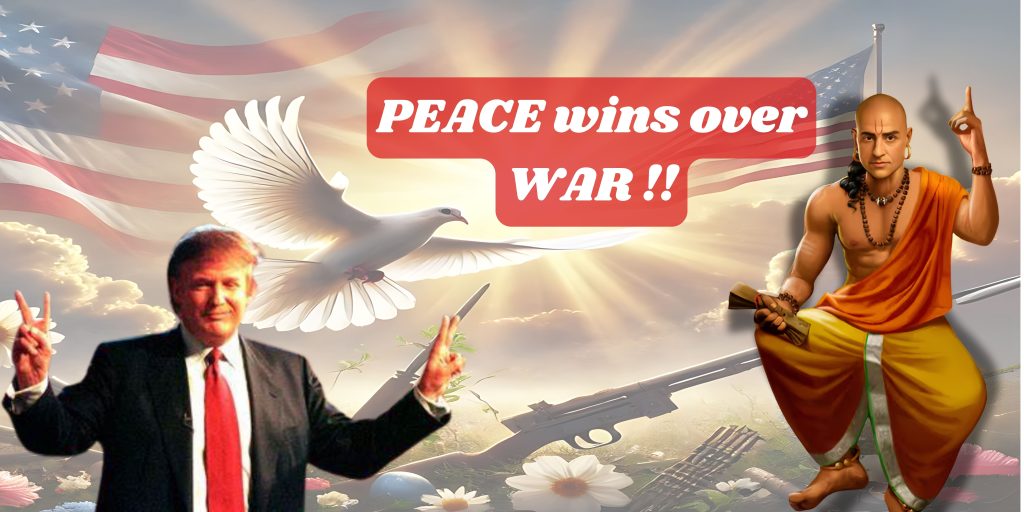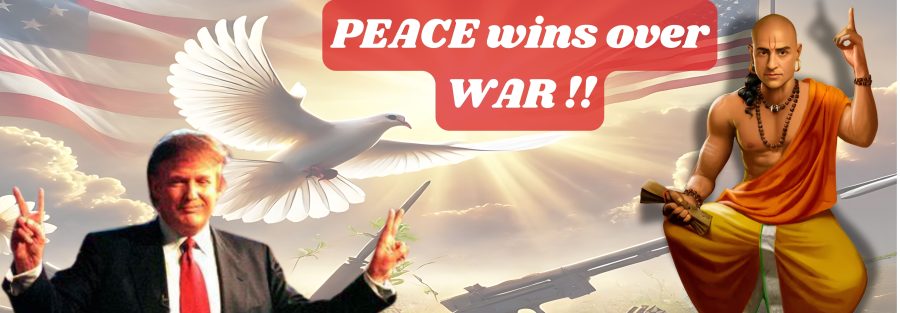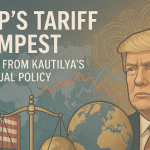
Donald Trump’s historic second-term victory in the 2024 US Presidential Election has sparked conversations around leadership, power, and the dynamics of global influence. As the world grapples with the implications of his renewed mandate, it’s worth reflecting on the ancient wisdom of Kautilya—whose insights into governance, diplomacy, and the balance between power and peace offer timeless lessons for today’s leaders. While Trump’s assertive approach often emphasizes strength, Kautilya reminds us that sustainable leadership ultimately lies in harnessing peace, not just winning wars. This article explores why peace, as a strategic tool, holds the key to enduring leadership success, even amidst political upheaval.
The foundational concept of Kautilya’s statecraft, as captured in three core sutras from the Arthashastra, is essential to understand the dynamics of the 2024 US Presidential Campaign:
“शम.व्यायामौ योग.क्षेमयोर् योनिः ||”
(śamâ-vyāyāmau yogakṣemayor yonihṣ)
“Peace and activity constitute the source of acquisition and security” (6.2.1)
“कर्मारम्भाणां योगाराधनो व्यायामः ||”
(karma-ārambhāṇāṁ yoga-ārādhanō vyāyāmaḥ)
“Activity is that which brings about accomplishment of works undertaken” (6.2.2)
“कर्मफलोपभोगानां क्षेमाराधनः शमः ||”
(karma-phala-upabhogānāṁ kṣema-ārādhanah śamaḥ)
“Peace is that which ensures the security of the fruits of work” (6.2.3)
These sutras provide the framework for an integrated approach to governance: combining the pursuit of योग (yoga) – acquisition (new deveopments) with क्षेम (kṣema) – the consolidation and safeguarding of those developments. The interplay of शम (śama) – peace and व्यायामः (vyāyāma) – activity, reveals that both proactive efforts and tranquil consolidation are essential for sustained prosperity.
Donald Trump’s strategy during the 2024 US Presidential Campaign reflected this balanced governance approach as outlined by Kautilya. His campaign focused on economic stability, reshoring jobs, reducing international conflicts, and embracing new technologies. His slogan, “Make America Great Again”, encapsulated his focus on reinforcing American prosperity and well-being by prioritizing “America First” and limiting overseas military engagements.
Trump emphasized reducing “endless wars,” negotiating peace deals, and ensuring energy independence, which aligns with Kautilya’s concept of “योग-क्षेमयोः योनिः ||” (yoga-kṣemayoḥ yoniḥ) “Peace must be actively pursued to protect what is attained.” This highlights that lasting peace and security are vital to protect what has already been attained, rather than risking these gains through costly and unnecessary foreign interventions. It reflects Kautilya’s notion that sustainable governance requires both योग (yoga) – acquisition (new deveopments) and क्षेम (kṣema) – protection.
Kautilya further elaborates on the pillars of effective governance:
“वृद्धि, लाभ, पालन ||”
(vṛddhi, lābha, pālana)
“Growth, gains, and maintaining what is gained” (1.7.6)
The Sutra signifies sustaining what is gained. Trump’s focus on sustaining domestic welfare without excessive foreign involvement speaks directly to pālana. By prioritizing stability at home, he emphasized nurturing and safeguarding existing prosperity over aggressive new expansion—a principle deeply rooted in Kautilyan governance.
Another aspect of Trump’s campaign was his focus on leveraging modern technology to maintain the nation’s growth. His efforts to encourage investments in artificial intelligence (AI) and energy independence, inspired by technological advancements led by figures like Elon Musk, represent vṛddhi. However, Trump’s approach to clean energy was more mixed. While he promoted energy independence, his policies tended to favor traditional fossil fuels over clean energy and electric vehicles. His stance on renewable energy and electric vehicles was not as strong as other leaders, focusing instead on coal and oil industries. Despite this, he did recognize the role of AI in advancing national infrastructure and economic growth. This approach ensured that America was not only growing but also leading in key technological sectors, emphasizing national self-reliance and prosperity.
In contrast, Trump’s opponent adopted a more interventionist foreign policy stance, advocating for greater international commitments and interventions. This approach often aligns with भेद (bheda) – a divide-and-conquer tactic aimed at creating or exploiting divisions to establish influence and control, which can lead to external entanglements and potential internal instability.
The emphasis on welfare, unity, and technological advancement rather than divisive aggression aligns Trump’s campaign approach with Kautilya’s dharmic governance model, where the well-being of the people is the priority. This is reflected in the sutra:
“प्रजासुखे सुखं राञ: प्रजानां च हिते हितम् ||”
(prajāsukhe sukhaṁ raja, prajānāṁ ca hite hitam)
“In the happiness of the subjects lies the benefit of the leader and in what is beneficial to the subjects is his own benefit.” (1.19.34)
This principle is clearly reflected in Trump’s repeated emphasis on social stability, economic security, technological progress, and the overall well-being of American citizens, presenting a campaign that prioritized internal prosperity and unity.
Through a Kautilyan lens, the 2024 US Presidential campaign presented two contrasting approaches: शम एवं क्षेम (śama evaṁ kṣema) – peace and security versus विभेद एवं हस्तक्षेप (vibheda evaṁ hastakṣepa) – division and intervention. Trump’s reliance on preserving what has been gained over pursuing aggressive expansion exemplifies Kautilya’s principle that peace, along with the resulting prosperity and security, triumphs over conflict-driven ambitions. His campaign’s focus on peace and well-being of the people, along with his well-known slogan “Make America Great Again”, underscored a strategy for enduring strength and balanced prosperity, demonstrating that peace, technological advancement, and internal unity are active foundations for sustainable power.




82 Comments
Manoj
Good observation & understanding on governence
Anonymous
🤗🙏
Dr Yash Jaiswal
Thank you for evaluating the whole scenario and discuss it with Kautilya’s lens
Prasad t l
Core values taught remains true and we need to appreciate different shapes
Shilpa Dharod
Today’s need is peace and progress. People want to leave a peaceful lives and progress and prosperity. And it’s proven fact that wars are not the solution.
Chanakya niti is all time successful theory.
Your perceptions are very nice and efforts are in the right direction.
Keep it up.
Hitendra
Rightly stated.
Any open enemy is far better than an enemy in disguise.
Anonymous
Peace wins over war
👏👏👏👏👏👏👏
Nigel3510
https://vitz.ru/forums/index.php?autocom=gallery&req=si&img=4905
Oliver4195
http://terios2.ru/forums/index.php?autocom=gallery&req=si&img=4645
Kayla3525
Very good https://rb.gy/4gq2o4
Fiona1205
https://mazda-demio.ru/forums/index.php?autocom=gallery&req=si&img=6558
Gianna1633
https://mazda-demio.ru/forums/index.php?autocom=gallery&req=si&img=6562
Gianna1333
http://toyota-porte.ru/forums/index.php?autocom=gallery&req=si&img=3264
Faye1005
https://myteana.ru/forums/index.php?autocom=gallery&req=si&img=6659
Jesse4989
http://wish-club.ru/forums/index.php?autocom=gallery&req=si&img=5291
Maggie2328
http://terios2.ru/forums/index.php?autocom=gallery&req=si&img=4612
Fernando3658
http://wish-club.ru/forums/index.php?autocom=gallery&req=si&img=5502
Alejandra3215
http://wish-club.ru/forums/index.php?autocom=gallery&req=si&img=5240
Dominique1935
https://vitz.ru/forums/index.php?autocom=gallery&req=si&img=4824
Marcel3289
http://terios2.ru/forums/index.php?autocom=gallery&req=si&img=4555
Lynda1475
https://honda-fit.ru/forums/index.php?autocom=gallery&req=si&img=7075
Derrick1244
http://wish-club.ru/forums/index.php?autocom=gallery&req=si&img=5260
Cora2352
http://toyota-porte.ru/forums/index.php?autocom=gallery&req=si&img=3251
Rochelle2464
https://hrv-club.ru/forums/index.php?autocom=gallery&req=si&img=6924
Teresa1545
http://wish-club.ru/forums/index.php?autocom=gallery&req=si&img=5263
Amalia2916
http://wish-club.ru/forums/index.php?autocom=gallery&req=si&img=5260
Hank1252
https://mazda-demio.ru/forums/index.php?autocom=gallery&req=si&img=6375
Dale1598
http://toyota-porte.ru/forums/index.php?autocom=gallery&req=si&img=3271
Stephen3976
Афина – Слишком поздно скачать песню бесплатно в mp3 и слушать онлайн https://shorturl.fm/1Vwe8
Carlos3845
RYZE – Тебя манят скачать mp3 и слушать бесплатно https://shorturl.fm/OL8e3
Ella1349
Жан Татлян – Песня о капели скачать песню бесплатно в mp3 и слушать онлайн https://shorturl.fm/2h3zV
Eric2529
Маша и Медведь – Песня сладкоежки скачать песню в mp3 и слушать онлайн https://shorturl.fm/3YwiY
Kiera4310
140 Ударов В Минуту – Ой-Ой-Ой ( 2001 ) скачать и слушать песню бесплатно https://shorturl.fm/0j7z2
Eddie4519
Silver Nail,Aruba Ice,Syntheticsax – Прекрасное далеко (Radio edit) скачать песню и слушать бесплатно https://shorturl.fm/U6UJ8
Dylan2013
Агата Кристи – Сказочная тайга скачать песню в mp3 и слушать онлайн https://shorturl.fm/7GgYe
Kira3867
Artik & Asti, Артём Качер – Грустный дэнс скачать и слушать песню бесплатно https://shorturl.fm/gVhw5
Edmund3388
Jah Khalib – На своём вайбе (feat. Гуф) скачать mp3 и слушать бесплатно https://shorturl.fm/VEqtm
Haleigh2701
https://shorturl.fm/YvSxU
Brett790
https://shorturl.fm/j3kEj
Samantha4614
https://shorturl.fm/oYjg5
Zane726
https://shorturl.fm/A5ni8
Dean1793
https://shorturl.fm/N6nl1
Beryl1332
https://shorturl.fm/a0B2m
Annette835
https://shorturl.fm/a0B2m
Jonas4934
https://shorturl.fm/oYjg5
Sydney1848
https://shorturl.fm/N6nl1
Matthew4183
https://shorturl.fm/YvSxU
Jolene3660
https://shorturl.fm/a0B2m
Payton3981
http://terios2.ru/forums/index.php?autocom=gallery&req=si&img=4582
Tracy665
https://vitz.ru/forums/index.php?autocom=gallery&req=si&img=5095
Jamal705
https://honda-fit.ru/forums/index.php?autocom=gallery&req=si&img=6933
Ruby3215
https://mazda-demio.ru/forums/index.php?autocom=gallery&req=si&img=6545
Luis668
https://honda-fit.ru/forums/index.php?autocom=gallery&req=si&img=7338
Dakota4363
https://myteana.ru/forums/index.php?autocom=gallery&req=si&img=6839
Celia3336
http://terios2.ru/forums/index.php?autocom=gallery&req=si&img=4769
Mike457
https://honda-fit.ru/forums/index.php?autocom=gallery&req=si&img=7062
Diana4868
https://hrv-club.ru/forums/index.php?autocom=gallery&req=si&img=7165
Ally2115
https://shorturl.fm/XIZGD
Ana2678
https://shorturl.fm/TbTre
Ramona4245
https://shorturl.fm/YvSxU
Kai4749
https://shorturl.fm/N6nl1
Alexia4734
https://shorturl.fm/m8ueY
Elliott215
https://shorturl.fm/6539m
Campbell3640
https://shorturl.fm/5JO3e
Kristen3421
https://shorturl.fm/TDuGJ
Sara1179
https://shorturl.fm/LdPUr
Elliott2888
https://shorturl.fm/JtG9d
Roger3645
https://shorturl.fm/uyMvT
Vincent4226
https://shorturl.fm/hevfE
Angie442
https://shorturl.fm/f4TEQ
Percy1031
https://shorturl.fm/retLL
Serenity1765
https://shorturl.fm/LdPUr
Christian3018
Unlock exclusive rewards with every referral—enroll now! https://shorturl.fm/lzIC3
Mara372
Refer friends, earn cash—sign up now! https://shorturl.fm/eURc8
David1446
Apply now and receive dedicated support for affiliates! https://shorturl.fm/I8Fbh
Ariana2295
Share our products and watch your earnings grow—join our affiliate program! https://shorturl.fm/NkZEy
Anabel4555
Refer and earn up to 50% commission—join now! https://shorturl.fm/yPoQZ
Iris3051
Earn recurring commissions with each referral—enroll today! https://shorturl.fm/1pLja
Doug1000
Get started instantly—earn on every referral you make! https://shorturl.fm/Hm1Ha
Brock4779
Share your unique link and earn up to 40% commission! https://shorturl.fm/iOxfy
Chris1667
Start earning every time someone clicks—join now! https://shorturl.fm/zwxMy
Ebony2383
Sign up for our affiliate program and watch your earnings grow! https://shorturl.fm/IB2UQ